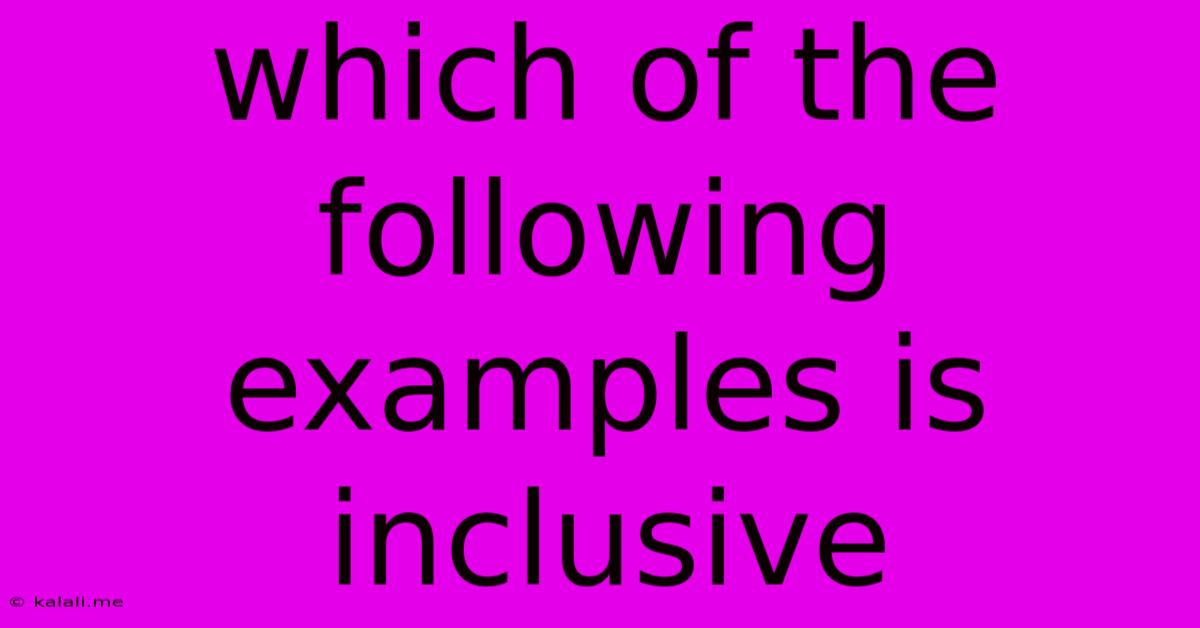Which Of The Following Examples Is Inclusive
Kalali
Jun 15, 2025 · 3 min read

Table of Contents
Which of the Following Examples is Inclusive? A Deep Dive into Inclusive Language and Practice
This article explores the concept of inclusivity and analyzes various examples to determine which demonstrates genuine inclusiveness. We'll delve into the nuances of language and behavior, identifying key elements that foster a truly inclusive environment. Understanding inclusivity is crucial for building respectful and equitable communities, both online and offline.
What is Inclusivity?
Inclusivity is more than just tolerance; it's about actively creating environments where everyone feels welcome, valued, and respected, regardless of their background, identity, or abilities. It involves acknowledging and celebrating differences, ensuring equal opportunities, and actively challenging discrimination. Inclusive language and actions are fundamental to achieving this.
Analyzing Examples of Inclusivity (Hypothetical Scenarios):
To illustrate the concept effectively, let's analyze a few hypothetical scenarios and determine which exhibits genuine inclusivity:
Scenario 1: The Company Meeting
- Example A: The company meeting begins with the CEO stating, "Gentlemen, let's get started."
- Example B: The company meeting begins with the CEO stating, "Good morning, everyone. Let's begin our meeting."
Analysis: Example A demonstrates exclusionary language. Using "Gentlemen" excludes women and other genders. Example B utilizes inclusive language, addressing everyone present and creating a more welcoming atmosphere. This simple change promotes a sense of belonging for all attendees.
Scenario 2: The Team Project
- Example A: The project team, composed entirely of people from the same cultural background, works efficiently but lacks diverse perspectives.
- Example B: The project team actively seeks individuals from diverse backgrounds, including different ethnicities, genders, ages, and abilities. They leverage these varied perspectives to foster creativity and innovation.
Analysis: Example A, while efficient, lacks inclusivity. A homogeneous team risks overlooking valuable insights and perspectives from different backgrounds. Example B actively promotes inclusivity by valuing diversity and creating a collaborative environment that benefits from multiple viewpoints. This approach leads to richer outcomes and stronger team cohesion. Consider aspects like accessibility – is the project accessible to people with disabilities?
Scenario 3: The Community Event
- Example A: The community event promotes activities primarily designed for able-bodied individuals, with limited consideration for those with disabilities.
- Example B: The community event offers a variety of inclusive activities, ensuring accessibility for individuals with different abilities. This might include wheelchair-accessible locations, sign language interpretation, and alternative formats for information.
Analysis: Example A displays a lack of consideration for people with disabilities, excluding a significant segment of the community. Example B showcases true inclusivity by actively incorporating accessibility measures, ensuring that everyone can participate and enjoy the event. Consideration for neurodiversity is also key here.
Key Elements of Inclusive Language and Practice:
- Using gender-neutral language: Avoid terms like "chairman" and use alternatives such as "chairperson" or "chair."
- Avoiding stereotypes and generalizations: Be mindful of the language you use and avoid making assumptions about individuals based on their background.
- Actively seeking diverse perspectives: Encourage participation from individuals with diverse backgrounds and actively listen to their viewpoints.
- Promoting accessibility: Ensure that events, materials, and environments are accessible to individuals with disabilities.
- Creating a safe and welcoming space: Foster an environment where individuals feel comfortable expressing themselves without fear of judgment or discrimination.
Conclusion:
True inclusivity requires conscious effort and a commitment to creating environments where everyone feels valued and respected. By understanding the nuances of inclusive language and practice, and by actively challenging exclusionary behaviors, we can build more equitable and thriving communities. Remember that inclusivity is an ongoing process requiring constant learning, adaptation, and a commitment to continuous improvement.
Latest Posts
Latest Posts
-
What Is The Antonym For Abundant
Jun 15, 2025
-
Which Of The Following Combinations Are Correctly Matched
Jun 15, 2025
-
In The Two Dimensional Body Illustrated The Gradient At Surface A
Jun 15, 2025
-
Movement Of A Limb Toward The Midline Of The Body
Jun 15, 2025
-
What Element Is Found In Proteins
Jun 15, 2025
Related Post
Thank you for visiting our website which covers about Which Of The Following Examples Is Inclusive . We hope the information provided has been useful to you. Feel free to contact us if you have any questions or need further assistance. See you next time and don't miss to bookmark.